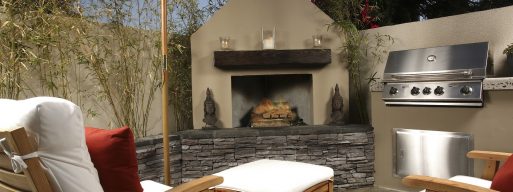Outdoor Fire Safety Tips to Keep You and Your Home Safe
Firepits are an excellent addition to backyard enjoyment in the summer. But since firepits are like an outdoor fireplace, you need to take the same fire safety precautions as you would any other appliance with flames.
So whether you opt for a fire table or a wood-burning firepit, here are some outdoor fire safety tips to keep you and your home safe this summer.
Keeping Your Family, Friends, And Property Safe
When firepit safety isn’t a priority, there is a high risk of injury, fire spreading, and properties burning. Embers can fly out and create fires in the grass and on nearby structures. And people and pets can fall into open flames. So keep your family, guests, pets, and home safe by using these fire safety tips.
How to Stay Safe
Proper Firepit Positioning
Make sure the chosen site for your firepit is safe. The ground should be level—especially for portable firepits. The base should also be non-flammable, such as concrete slabs and patio pavers. Avoid placing firepits on grass and wood decks.
Your firepit should be at least 10 to 25 feet away from any buildings, plants, and neighbouring yards.
Do not place your firepit under overhangs or in enclosed or partially-enclosed areas. Also, avoid placing your firepit under low-hanging tree branches.
For seating around your firepit, position your chairs so people can easily get up and move around the seats with enough space to avoid the risk of falling into the open flames.
Use the Right Fuel – Avoid Accelerants
Use the right fuel type depending on the type of firepit you have—e.g., gas or wood-burning.
Do not use flammable fluids, such as gasoline or lighter fluid, to light a wood-burning firepit. Instead, use kindling on top of a commercial fire starter stick.
Also, don’t throw garbage and paper products into the fire since these tend to spark and throw burning pieces into the air.
Softwoods, like pine and cedar, also pop and throw sparks. And pressure-treated wood emits harmful toxins when burned. So only use dry, well-seasoned firewood.
Light Safely & Never in Heavy Winds
Clean up leaves and other combustible materials before lighting fires. And avoid trying to light your firepit during windy conditions since wind can blow embers and cause fires to spread.
Also, don’t wear loose, flammable clothing, like nylon, and don’t light big fires. The bigger the flames, the greater the risk of your fire spreading.
Never Leave a Firepit Unattended
Always have someone watching a lit firepit, never leaving it unattended. Especially never leaving it unattended with pets or children nearby.
Always Put Out Fires Fully
When you’re done enjoying your firepit for the night, put out the fire completely. Follow the manufacturer’s instructions for extinguishing fires.
Some wood-burning firepits can be doused with water and stirred with a shovel to extinguish. The ashes should then be shovelled into a metal fireproof container since the ashes can remain hot for up to a week.
Check for Burn Bans
Look for local burn bans before lighting your firepit. If there is a burn ban in place, then the conditions are too dry to safely have a fire since flying embers can start fast-burning fires.
Depending on where you live, you may also need a burn permit, so check your municipality’s website first.
Helpful Firepit Tools
To put fire safety first, keep these handy firepit tools nearby this summer:
Fire Extinguishers
Keep a fully charged, dry-chemical fire extinguisher nearby to extinguish any out-of-hand flames. Your extinguisher should have a multipurpose, Class B, or Class C rating.
Learn the effective range (usually 6 to 10 feet) and how to properly use the extinguisher. Also, be sure to turn off the gas before extinguishing gas firepits.
When using the extinguisher, follow PASS procedure:
- Pull the pin
- Aim at the base of the fire
- Squeeze the trigger slowly
- Sweep the nozzle from side to side
Fire Blankets
Fire blankets are worth having in case you need to quickly extinguish sparks and fires that ignite outside of the firepit.
Firepit Screen
A wire mesh firepit cover can keep embers from flying out while also keeping pets and people from falling in.
Garden Hose
Keep a garden hose with the nozzle set to spray, or a bucket of water nearby each time you light a fire.
Tongs & Poker
To safely move your logs around, keep a set of fire tongs and a fire poker handy.
Shovels
Use a shovel to put out wood fires and extinguish any escaped flames.
Are Fire Tables Safe?
Fire tables are safe as long as you are safe about storing your propane tanks.
Proper Propane Storage
To keep you and your home safe, be sure to follow these propane storage guidelines:
- Closet the valve tightly and insert the safety plug
- Keep the valve protected from damage
- Store propane cylinders in an upright, secure position
- Do not store propane inside any structures—e.g., inside your home
- Store propane cylinders outdoors in a well-vented area; and
- Store the propane cylinder away from heat and flames
Firepit safety keeps everyone safe while preventing disasters. So, to make your summer nights by the fire as enjoyable as possible, keep everyone and your home safe with these firepit safety tips.


